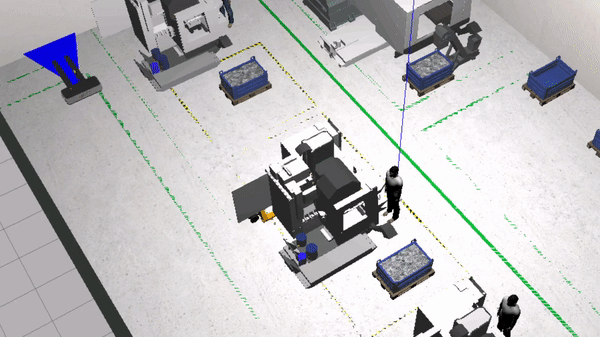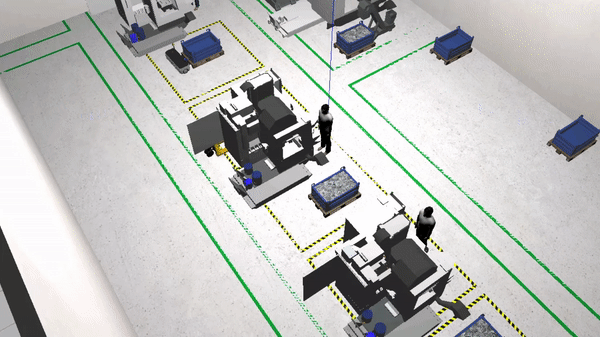The four industrial revolution (4IR) pushes the manufacturing industry to an integration with newest technologies like the Artificial Intelligence, additive manufacturing, augmented reality and the IoT internet of things. The 4IR also includes an advanced in connectivity between machines, robots, sensors, etc. that gives rise to “smart factories”.
The following project refers to a smart factory in which the IoT, the advanced connectivity and the ROS technology allow an autonomous management of the raw and waste materials. In particular, the environment, shown in the figure 1.1, reproduces a mechanical workshop for working metals with numerical control machines, where an AMR pallet truck ensures the handling of both raw or semi-finished pieces and the transport of residual metal shaving.
Figure 1.1: Mechanical workshop environment. (1) AMR pallet trucks, (2) CNC machine, (3) full chip bin, (4) empty chip bin.
In the following scenario, it is staged an example of management of the residual metal chip bin by the AMR pallet truck using a web interface, as shown in figure 1.2. It leaves the fully automatic management to a later implementation.
Figure 1.2: Web Interface. Buttons: (1) go to full bin, (2) fork the bin, (3) elevator up, (4) go to recycling, (5) elevator down, (6) disengagement bin, (7) recycling bin, (8) go to empty bin, (9) go to CNC machine, (10) go home, (11) move forward, (12) move backward, (13) move turn CW, (14) move turn CCW, (15) stop, (16) connect/disconnect. Readings: (17) odometry position, (18) obstacle distances.
The project, created using ROS Noetic and Python language, has been divided into four main parts:
- Gazebo simulation
- chip bin management
- navigation
- usage
The first part concerns the construction of the AMR and its environment, i.e. the mechanical workshop with CNC machines and the chip bins. The second one is dealing with the actions of the AMR, like: the detection, the engagement and the disengagement of the chip bin. The third regards the transport of both empty and full europallets. The last one is an explanation on how to do a chip bin replacement cycle using a web interface. To achive these objectives 9 packages were created, grouped as follows:
- Gazebo simulation
- amr_description
- amr_environment
- chip bin management
- amr_detection
- amr_rendezvous
- amr_disengagement
- amr_webpage
- navigation
- amr_mapping
- amr_localization
- amr_navigation
- usage
The AMR_pallet_trucks project runs at least on UBUNTU 20.04 LTS and ROS Noetic. Refer to https://ubuntu.com/download/desktop and https://wiki.ros.org/noetic/Installation/Ubuntu to install them.
Install the following packages:
sudo apt-get update
sudo apt-get install ros-noetic-navigation
sudo apt-get install ros-noetic-rosbridge-suite
sudo apt-get install ros-noetic-ros-control ros-noetic-ros-controllers
sudo ln -s /usr/bin/python3 /usr/bin/python
Open a terminal and type
cd ~/catkin_ws/src
git clone https://github.com/motomechatronics/amr_pallet_trucks.git
cd ..
catkin_make
source devel/setup.bash
export NVM_DIR="/home/user/catkin_ws/src/amr_pallet_trucks/webpage_ws/nvm"
Edit main_project.launch file, with
cd ~/catkin_ws/src/amr_pallet_trucks/amr_description/launch
vim main_project.lauch
Comment this line and save the file.
<!--arg name="websocket_external_port" value="$(env SLOT_ROSBRIDGE_PORT)" /-->
Next, edit the .bashrc file
vim ~/.bashrc
At the end of the file, (press i) copy and paste:
source /opt/ros/noetic/setup.bash
source /usr/share/gazebo/setup.sh
export GAZEBO_RESOURCE_PATH=usr/share/gazebo-11/models:$HOME/catkin_ws/src/amr_pallet_trucks:$HOME/catkin_ws/src/amr_pallet_trucks/amr_environment/models:$HOME/catkin_ws/src/amr_pallet_trucks/amr_environment
export GAZEBO_MODEL_PATH=/usr/share/gazebo-11/models:$HOME/catkin_ws/src/amr_pallet_trucks:$HOME/catkin_ws/src/amr_pallet_trucks/amr_environment/models:$HOME/catkin_ws/src/amr_pallet_trucks/amr_environment
export NVM_DIR="$HOME/catkin_ws/src/amr_pallet_trucks/amr_webpage/nvm"
[ -s "$NVM_DIR/nvm.sh" ] && \. "$NVM_DIR/nvm.sh" # This loads nvm
[ -s "$NVM_DIR/bash_completion" ] && \. "$NVM_DIR/bash_completion" # This loads nvm bash_completion
alias webpage_address='echo http://127.0.0.1:7000'
alias rosbridge_address='echo ws://127.0.0.1:9090'
press esc and save typing inside vim environment
:wq!
In the same terminal
source ~/.bashrc
nvm ls
nvm install v14
nvm alias default v14
npm install -g http-server
In the case you have UBUNTU installed in your PC, type
cd ~/catkin_ws/src
git clone https://github.com/motomechatronics/amr_pallet_trucks.git
Install Docker if it is not present in your system, typing
sudo apt-get update
sudo apt-get install docker.io docker-compose
sudo service docker start
Then you can already work with Docker (with sudo):
sudo docker ps
sudo docker images
To create an image of the projet, open a terminal and type:
cd ~/catkin_ws/src/amr_pallet_trucks/
sudo docker build -f dockerfile_amr_pallet_trucks_project -t amr_ptp:latest .
After that, run the image in the container, typing:
sudo docker run -it amr_ptp
Now, you should be inside the UBUNTU system like root. Type:
source devel/setup.bash
vim src/amr_pallet_trucks/amr_description/launch/main_project.launch
Press i letter and comment the line as follow:
<!--arg name="websocket_external_port" value="$(env SLOT_ROSBRIDGE_PORT)" /-->
press esc, type :wq! and press enter.
Launch the project with:
roslaunch amr_description main_project.launch
Open another terminal and type:
sudo docker ps
You will get a list of the containers. Copy and paste the container ID of the image amr_ptp as below:
sudo docker exec -it 3e31851e18ad bash
Now, you can explore the project, for example you can visualize the /front_scan topic, with:
rostopic echo /front_scan
Or you can visualize the list of the topics or of the servers:
rostopic list
rosservice list
Open a terminal and type
cd ~/catkin_ws
source devel/setup.bash
roslaunch amr_description main_project.launch
Open another terminal and type
cd ~/catkin_ws/src/amr_pallet_trucks/amr_webpage/
http-server --port 7000
Open another terminal and type
webpage_address
You will get a web link as http://127.0.0.1:7000. Copy and paste the link in a browser. After in the same terminal type
rosbridge_address
You will get a link as ws://127.0.0.1:9090, copy and paste the string into the rosbrigde address field, shown in figure 3.1 and press the connect button.
Figure 3.1: Web Interface. Buttons: (1) go to full bin, (2) fork the bin, (3) elevator up, (4) go to recycling, (5) elevator down, (6) disengagement bin, (7) recycling bin, (8) go to empty bin, (9) go to CNC machine, (10) go home, (11) move forward, (12) move backward, (13) move turn CW, (14) move turn CCW, (15) stop, (16) connect/disconnect. Readings: (17) odometry position, (18) obstacle distances.
At the moment the project manages only one bin, not selectable. The procedure to stage a substitution cycle is the following:
- press the go to full bin button, the expected result is shown in figure 3.2.
after that,
- press the fork the bin button and next the elevator up button, the expected result is shown in figure 3.3.
- press the go to recycling button and next the elevator down button, the expected result is shown in figure 3.4.
- press the disengagement button and when the AMR will be disengaged, press the recycling bin and the go to empty bin buttons. The expected result is shown in figure 3.5.
Figure 3.5: result of pressing the disengagement bin, the recycling bin and the go to empty bin buttons.
- press the fork the bin button and, when the chip bin is forked, press elevator up button. The expected result is shown in figure 3.6.
- press the go to cnc machine button and next the elevator down button, the expected result is shown in figure 3.7.
- by pressing the disengagement and the go home buttons the cycle ends. The expected result is shown in figure 3.8.
We are designing the real pallet truck. We will update you on the work in progress. The images below show you a simple implementation.











